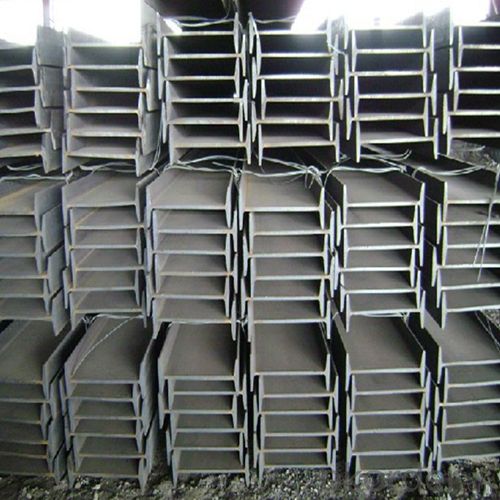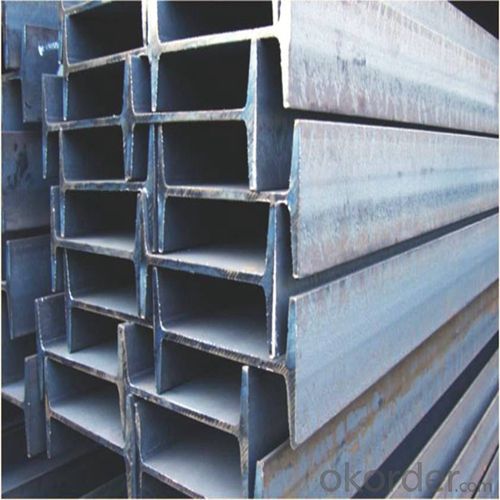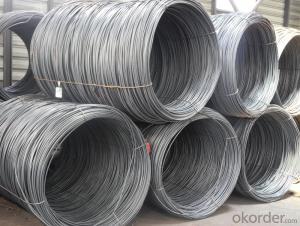Steel Deformed Rebar In Coil Small Sizes for Construction
- Loading Port:
- China main port
- Payment Terms:
- TT or LC
- Min Order Qty:
- 25 m.t.
- Supply Capability:
- 10000 m.t./month
OKorder Service Pledge
OKorder Financial Service
You Might Also Like
1. Structure of Steel Deformed Rebar In Coil Small Sizes for Construction Description:
Steel deformed rebar in coil small sizes for construction is a beam with an I-shaped cross-section. The horizontal elements of the "I" are known as flanges, while the vertical element is termed the "web". Steel deformed rebar in coil small sizes for construction is usually made of structural steel and is used in construction and civil engineering. The steel deformed rebar in coil small sizes for construction resists shear forces, while the flanges resist most of the bending moment experienced by the beam. Steel deformed rebar in coil small sizes for construction theory shows that the I-shaped section is a very efficient form for carrying both bending and shears loads in the plane of the web.
2. Main Features of Steel Deformed Rebar In Coil Small Sizes for Construction:
• Grade: Q235
• Type: Mild carbon steel
• Deflection: The stiffness of the I-beam will be chosen to minimize deformation
• Vibration: The stiffness and mass are chosen to prevent unacceptable vibrations, particularly in settings sensitive to vibrations, such as offices and libraries.
• Local yield: Caused by concentrated loads, such as at the beam's point of support.
3. Steel Deformed Rebar In Coil Small Sizes for Construction Images:



4. Steel Deformed Rebar In Coil Small Sizes for Construction Specification:
Mechanical Properties | Grade | Steel diameter(mm) | |||
≤16 | 16~40 | 40~60 | 60~100 | ||
Yield Point Δs/MPa | Q195 | ≥195 | ≥185 | - | - |
Q235 | 235 | 225 | 215 | 205 | |
Tensile Strength | Q195 | 315~390 | |||
Q235 | 375~500 | ||||
Elongation δ5% | Q195 | ≥33 | ≥32 | - | - |
Q235 | 26 | 25 | 24 | 23 | |
5. FAQ
We have organized several common questions for our clients,may help you sincerely:
①Is this product same as W beam?
In the United States, the most commonly mentioned I-beam is the wide-flange (W) shape. These beams have flanges in which the planes are nearly parallel. Other I-beams include American Standard (designated S) shapes, in which flange surfaces are not parallel, and H-piles (designated HP), which are typically used as pile foundations. Wide-flange shapes are available in grade ASTM A992,[4] which has generally replaced the older ASTM grades A572 and A36.
②How to inspect the quality?
We have a professional inspection group which belongs to our company. We resolutely put an end to unqualified products flowing into the market. At the same time, we will provide necessary follow-up service assurance.
③Is there any advantage about this kind of product?
Steel I beam bar IPE has a reduced capacity in the transverse direction, and is also inefficient in carrying torsion, for which hollow structural sections are often preferred.
- Q:Are there any safety concerns related to handling steel rebars?
- Yes, there are safety concerns related to handling steel rebars. Some of the potential hazards include cuts and punctures from sharp edges, strains and sprains from lifting heavy rebars, and potential injuries from falling rebars if they are not properly secured. It is important to wear appropriate personal protective equipment, use proper lifting techniques, and ensure secure storage and handling to minimize the risks associated with steel rebars.
- Q:What is the process of connecting steel rebars to structural members?
- The process of connecting steel rebars to structural members is typically done through a method called rebar tying. This involves placing the rebars in the desired positions within the structural member, and then using wire or steel tie rods to securely fasten the rebars to the member. The ties are typically twisted or tightened to ensure a strong and reliable connection between the rebars and the structural member. This process is crucial in reinforcing concrete structures and ensuring their strength and stability.
- Q:What is the cost of steel rebars?
- Different factors, including steel grade, market conditions, and location, can cause the price of steel rebars to vary. Generally, the price ranges from $500 to $800 per metric ton. Nevertheless, it is crucial to consider that prices can change due to factors like supply and demand, raw material expenses, and any taxes or tariffs imposed on steel imports. To obtain the most accurate and current pricing information, it is advisable to reach out to local suppliers or consult market reports.
- Q:What are the different shapes of steel rebars?
- Steel rebars, also known as reinforcing bars, come in various shapes, including round, square, and deformed. The round rebar is the most common type, while square rebars provide better grip due to their flat sides. Deformed rebars have ridges or indentations, enhancing their bond with concrete and improving structural integrity.
- Q:How do steel rebars prevent cracking in concrete?
- The reinforcement provided by steel rebars is essential in preventing cracking in concrete. By increasing the overall strength and durability of the structure, steel rebars counteract the tensile forces that cause concrete to crack. To create a reinforcing mesh or framework, high-strength steel rebars are strategically placed within the concrete. This mesh acts as a skeleton, effectively absorbing and distributing the tensile forces throughout the structure. As a result, cracks are prevented from forming. When external loads, such as heavy weights or seismic forces, are applied to the concrete, the rebars bear the tensile stress instead of the concrete itself. This is possible because steel rebars have a much higher tensile strength compared to concrete. By distributing stress more evenly, the rebars minimize crack formation and help maintain the concrete's structural integrity. Additionally, steel rebars improve the bond between the concrete and the reinforcement, further preventing cracks. While concrete has excellent compressive strength, its tensile strength is relatively low. The inclusion of rebars increases the overall tensile strength of the concrete, reducing the likelihood of cracking under tension. The bond between the rebars and the concrete creates a composite material that can effectively withstand both compressive and tensile forces. In summary, steel rebars play a crucial role in preventing cracking in concrete. They provide reinforcement, absorb tensile forces, and enhance the overall strength and durability of the structure. By acting as a skeleton within the concrete and distributing stress, they prevent the formation of cracks and ensure the long-lasting stability of the construction.
- Q:What is the role of steel rebars in minimizing cracking due to shrinkage?
- The role of steel rebars in minimizing cracking due to shrinkage is to provide reinforcement and strength to concrete structures. By placing steel rebars within the concrete, they act as a framework that helps distribute the tensile forces caused by shrinkage. This prevents the concrete from cracking and ensures the overall stability and durability of the structure.
- Q:What is the process of deforming steel rebars for better adhesion with concrete?
- The process of deforming steel rebars for better adhesion with concrete is known as ribbing or rib formation. It involves creating a series of ribs or deformations along the surface of the rebars to increase their surface area and improve the bond strength between the steel and concrete. This is typically achieved by passing the rebars through a specialized machine that uses rollers or dies to shape the desired rib pattern. The resulting ribbed rebars provide enhanced mechanical interlocking with the concrete, ensuring a stronger and more durable bond in reinforced concrete structures.
- Q:How do steel rebars affect the overall constructability of a project?
- Steel rebars play a crucial role in enhancing the overall constructability of a project. They provide structural strength and stability to concrete structures, improving their durability and load-bearing capacity. By reinforcing concrete, rebars help prevent cracking, enhance resistance to tension forces, and increase the project's lifespan. Additionally, rebars enable the construction of complex shapes and designs, allowing for more versatile and innovative architectural designs. Overall, steel rebars significantly contribute to the construction process by ensuring the integrity and longevity of the project.
- Q:Are steel rebars suitable for reinforcement in parking garages?
- Yes, steel rebars are suitable for reinforcement in parking garages. They are commonly used due to their high tensile strength, durability, and ability to withstand heavy loads. Additionally, steel rebars provide structural stability and help prevent cracking or collapsing of the concrete in parking garages, making them an ideal choice for reinforcement.
- Q:Can steel rebars be used in composite construction systems?
- Yes, steel rebars can be used in composite construction systems. Composite construction refers to the combination of different materials, typically concrete and steel, to create a stronger and more efficient structure. Steel rebars are commonly used as reinforcement in concrete structures, providing added strength and durability. In a composite construction system, steel rebars are embedded within the concrete, creating a bond between the two materials. This combination allows for the utilization of the compressive strength of concrete and the tensile strength of steel, resulting in a highly efficient and resilient structure. The use of steel rebars in composite construction systems offers several benefits. Firstly, it enhances the structural integrity of the construction by increasing its load-bearing capacity and resistance to external forces such as earthquakes or heavy loads. Additionally, steel rebars help to control cracking and improve the overall durability of the structure. Furthermore, steel rebars offer flexibility in design and construction. They can be easily shaped and placed according to the specific requirements of the structure, allowing for complex and intricate designs. Moreover, steel rebars can be prefabricated off-site, making the construction process more efficient and time-effective. In conclusion, steel rebars are a crucial component of composite construction systems. Their usage in combination with concrete provides numerous advantages, including increased strength, durability, and flexibility.
1. Manufacturer Overview |
|
|---|---|
| Location | |
| Year Established | |
| Annual Output Value | |
| Main Markets | |
| Company Certifications | |
2. Manufacturer Certificates |
|
|---|---|
| a) Certification Name | |
| Range | |
| Reference | |
| Validity Period | |
3. Manufacturer Capability |
|
|---|---|
| a)Trade Capacity | |
| Nearest Port | |
| Export Percentage | |
| No.of Employees in Trade Department | |
| Language Spoken: | |
| b)Factory Information | |
| Factory Size: | |
| No. of Production Lines | |
| Contract Manufacturing | |
| Product Price Range | |
Send your message to us
Steel Deformed Rebar In Coil Small Sizes for Construction
- Loading Port:
- China main port
- Payment Terms:
- TT or LC
- Min Order Qty:
- 25 m.t.
- Supply Capability:
- 10000 m.t./month
OKorder Service Pledge
OKorder Financial Service
Similar products
New products
Hot products
Hot Searches
Related keywords




























